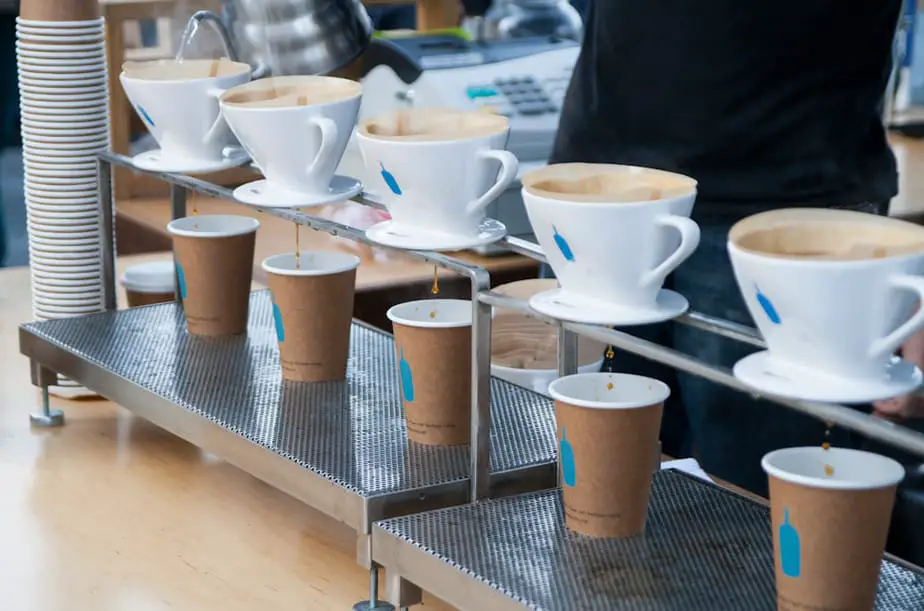You know: that very same brand with cobalt insignia—threatening to dismantle local landmarks?
Oh, hey there, Blue Bottle! Can you please top trying to be Starbucks? You’re kind of messing things up around here.
And, should you ever find yourself corralled into the bowels of a Blue Coffee café, you’re struck with a familiar chord: it’s a small coffee chain trying to desperately scale at large without loosing it’s touted new-age ma-and-pa ambiance.
But, alas, you can’t help but feel like you’ve been treated like something akin to a lab rat after you’re eventually handed your double-shot of espresso.
The walls are white; the cups are white; the ceilings are white. There’s eco-chic, sustainable wood wherever your hand makes contact. There’s big-block text labeling their brown-bagged products, inscribed in a way that aims to soften your bloodshot eyes—courtesy of affable brand placements. Barista’s greet you with pleasant conversation, their words warm with promise and a certain karmic hope.
(That blinding optimism veiled by a need to be generously tip…so they can make their Tenderloin rent payments. Before they get evicted. Again. )
Patrons, dressed in their flouncy couture or form-fitting elastic, coddle their five-dollar caffeinated concoctions, snapping and filtering and uploading their afternoon or morning pick-me-ups to appease their sense of self-worth on social media.
Ring a bell, anyone?
Sure, there are some clear-cut difference between the eponymously colored brands. No bigger difference, I think, exists than the one contrasting the two founding CEOs themselves.
James Freeman, the founder and CEO of Blue Bottle who yearned to introduce an old New Orleans drink back to the humble masses, began his company on whim a decade ago in downtown Berkeley. Then we have Howard Schultz: a man who, after a trip spent in Italy on behalf o the Seattle-based coffee company’s, wanted to bring back the same ritualistic manner held by the southern Europeans to the states.
The rest—for both brands—is history; they’ve each broken into foreign markets beyond their initial customer bases.
I can still recall how fiercely my face tensed when I saw a line of twelve six-ounce canned Blue Bottle products among the other offerings at Austin’s Whole Foods Headquarters.
Now, granted, to those among us who aren’t Bay Area locals, may find the brand endearing, dare I say avant garde in their approach to icing coffee. Alexis Madrigal—a name, frankly, straight-out of the pages of Rowling novel—waxed poetic on her newfound love affair with the want-to-be coffee mogul in The Atlantic earlier this year. And she has every right to; it’s not bad coffee.
It’s just the fact that we don’t need another communal gathering spot for Ugg boots in San Francisco.
Ok, Blue Bottle?

title: “Blue Bottle Can You Please Stop Trying To Be The New Starbucks " ShowToc: true date: “2022-11-22” author: “Simon Rosas”
You know: that very same brand with cobalt insignia—threatening to dismantle local landmarks?
Oh, hey there, Blue Bottle! Can you please top trying to be Starbucks? You’re kind of messing things up around here.
And, should you ever find yourself corralled into the bowels of a Blue Coffee café, you’re struck with a familiar chord: it’s a small coffee chain trying to desperately scale at large without loosing it’s touted new-age ma-and-pa ambiance.
But, alas, you can’t help but feel like you’ve been treated like something akin to a lab rat after you’re eventually handed your double-shot of espresso.
The walls are white; the cups are white; the ceilings are white. There’s eco-chic, sustainable wood wherever your hand makes contact. There’s big-block text labeling their brown-bagged products, inscribed in a way that aims to soften your bloodshot eyes—courtesy of affable brand placements. Barista’s greet you with pleasant conversation, their words warm with promise and a certain karmic hope.
(That blinding optimism veiled by a need to be generously tip…so they can make their Tenderloin rent payments. Before they get evicted. Again. )
Patrons, dressed in their flouncy couture or form-fitting elastic, coddle their five-dollar caffeinated concoctions, snapping and filtering and uploading their afternoon or morning pick-me-ups to appease their sense of self-worth on social media.
Ring a bell, anyone?
Sure, there are some clear-cut difference between the eponymously colored brands. No bigger difference, I think, exists than the one contrasting the two founding CEOs themselves.
James Freeman, the founder and CEO of Blue Bottle who yearned to introduce an old New Orleans drink back to the humble masses, began his company on whim a decade ago in downtown Berkeley. Then we have Howard Schultz: a man who, after a trip spent in Italy on behalf o the Seattle-based coffee company’s, wanted to bring back the same ritualistic manner held by the southern Europeans to the states.
The rest—for both brands—is history; they’ve each broken into foreign markets beyond their initial customer bases.
I can still recall how fiercely my face tensed when I saw a line of twelve six-ounce canned Blue Bottle products among the other offerings at Austin’s Whole Foods Headquarters.
Now, granted, to those among us who aren’t Bay Area locals, may find the brand endearing, dare I say avant garde in their approach to icing coffee. Alexis Madrigal—a name, frankly, straight-out of the pages of Rowling novel—waxed poetic on her newfound love affair with the want-to-be coffee mogul in The Atlantic earlier this year. And she has every right to; it’s not bad coffee.
It’s just the fact that we don’t need another communal gathering spot for Ugg boots in San Francisco.
Ok, Blue Bottle?
